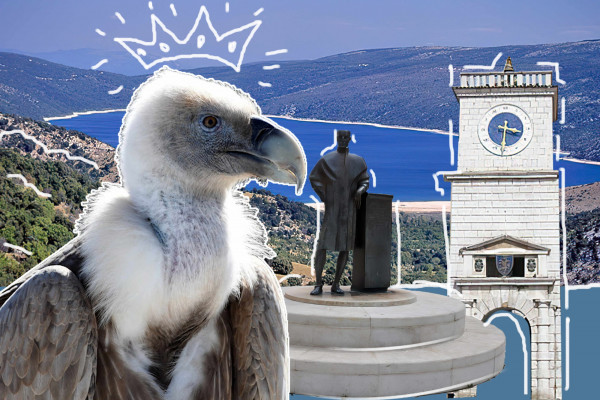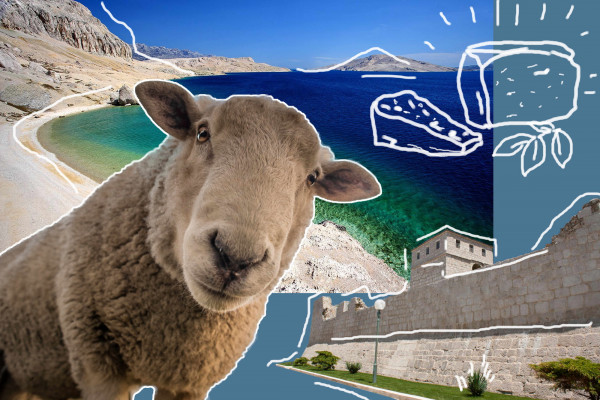Show all photos
Spiritual Journey Through Istria
This largest Croatian peninsula was once adorned with as many as 1,500 churches. To this day, many of them have been preserved, creating an extremely rich sacral heritage. Apart from churches with relics and places of pilgrimage, a significant place in the spiritual life of Istria is made up of very valuable frescoes in old churches and other places of power and old religions.
If you have decided to set out in search of spiritual peace in Istria, the following places should definitely be included in the itinerary.
1. Church of St. Blaise in Vodnjan - The Vodnjan parish church of St. Blaise keeps a total of 370 registered relics or earthly remains of as many as 250 saints. An indisputable scientific explanation of their perfect preservation over the years has not yet been found; it is assumed that the body can be preserved for so long under certain circumstances: at low temperatures, if death occurred due to arsenic poisoning, or if the body is buried in soil rich in iron and tannin.
2. Mali Sveti Andeo near Porec - Mali Sveti Andeo is a Croatian Stonehenge. It is a hill on which stone blocks (megaliths) are arranged in a circle. There are no blocks on the north side, indicating cult purposes related to the Sun and other celestial bodies. It is assumed that the site originated around 2000-1000 BC, and is named after the hill on which it is located.
3. Church of St. Fosca in the field near Vodnjan - This church from the end of the 11th century is known for its preserved monumental medieval frescoes, but also for the many miracles that took place there. Many believers testify to the unusual energy in the church, they mention cures from serious illnesses and that women who could not get pregnant for a long time remained pregnant after visiting the church. Istrians also have the saying "Saint Fosca, makes miracles happen".
4. Church of St. Euphemia in Rovinj - Euphemia was a girl from Greece, in the 3rd century, who converted to Christianity. According to the old belief, she became a martyr of the emperor Diocletian because she preached a faith that was not accepted at the time. Encouraged by this, Diocletian threw her among the lions, but she was saved by the descent of an angel from heaven, without a single bite. By this miracle, Euphemia was called a saint and martyr of Christianity after her death. In the 18th century, her heavy stone sarcophagus with relics sailed from Constantinople to the city of Rovinj, where its inhabitants dragged it with animals to the site of the then Church of St. George, which became Euphemia's temple and eternal resting place visible today. Saint Euphemia is also the patron saint of the city of Rovinj, whose day is celebrated on September 16. Many visitors come to Rovinj just then, on a holy pilgrimage to pay their respects.
5. Church of Our Lady of Health near Marcana - Church of Our Lady of Health is one of the most important places of pilgrimage in Istria. The church was built in the first half of the 18th century on the remains of an older church. Every year on the second Sunday in October, believers gather in this church to take part in a procession with a statue of the Mother of God of Health around the church.
6. Church of St. Marija na Skriljinah - Church of St. Marija na Skriljinah is a Gothic church located one kilometer from the center of Beram. It is best known for a cycle of medieval frescoes painted by Vincent of Kastav in the 15th century. Although experts believe that the scene Adoration of the Kings is Vincent's most valuable work, the most popular scene is the Dance of the Dead. It is also one of the oldest depictions of this topic. The lesson is that before death we are all equal and that no one can escape it, so the pope, cardinal, bishop, king and queen, fat innkeeper, child, beggar, soldier and merchant walk towards the open grave with the dancing dead.
7. Euphrasian Basilica in Porec - Arriving in Porec, the then Parentium, Bishop Euphrasius could not reconcile himself with the modesty of the existing church or the lethargy of a small provincial town. Inspired by Byzantine art, Euphrasius decided to build a basilica he will be remembered by. It was built on the remains of an older basilica, in the first half of the 6th century. Today, the Euphrasian Basilica is undoubtly the most valuable cultural monument in Porec, a UNESCO World Heritage Site and one of the best, untouched examples of Byzantine art in Europe. The greatest treasure of the Euphrasian Basilica are the magnificent mosaics that adorn the head of the apse. Fine art made fifteen centuries ago from multicolored stones still does not lose its shine and freshness.
8. Cathedral of the Assumption of the Blessed Virgin Mary in Pula - Inside the city, along the main street leading to the Forum from Flavius Road, there is a cathedral church. It was built on the site where Christians had gathered even at the time of the persecution of the church. The church has been extended and expanded over the centuries, its present form has been preserved by additions in the 17th century. Today it is the seat of the Bishop of Porec and Pula and the home of the remains of 5 saints resting in 5 sarcophagi.
9. Parish Church of St. Nicholas in Pazin - In its original form, it was built in 1266, upgraded during the 15th and 18th centuries. Of particular interest is the reticulated Gothic vault of the presbytery with a cycle of frescoes painted around 1460. These frescoes belong to the very top of late Gothic art in Istria. The same method of building the vault was used later in the construction of some other Istrian churches, including those in the Franciscan monastery in Pazin. The large church organ is the work of Gaetano Callido, and dates from 1780. In 1705, a 45 m high bell tower was erected next to the church.
10. Temple of Augustus in Pula - Although much can be seen on the Forum Square, your eyes will be fixed on the Temple of Augustus. A typical Roman building, this temple has a story that dates back to 14 AD. Changing functions over time from the temple of Emperor Augustus, to the church and finally the museum. Unfortunately, it was destroyed during World War II, so what you see now is a faithful reconstruction. Today it houses a museum, so you can enter and feel the special energy of this place.
Itinerary
Place 1
Church of St. Blaise in Vodnjan
Place 1
Church of St. Blaise in Vodnjan
The Vodnjan parish church of St. Blaise keeps a total of 370 registered relics or earthly remains of as many as 250 saints. An indisputable scientific explanation of their perfect preservation over the years has not yet been found; it is assumed that the body can be preserved for so long under certain circumstances: at low temperatures, if death occurred due to arsenic poisoning, or if the body is buried in soil rich in iron and tannin.
Place 2
Mali Sveti Andeo near Porec
Place 2
Mali Sveti Andeo near Porec
Mali Sveti Andeo is a Croatian Stonehenge. It is a hill on which stone blocks (megaliths) are arranged in a circle. There are no blocks on the north side, indicating cult purposes related to the Sun and other celestial bodies. It is assumed that the site originated around 2000-1000 BC, and is named after the hill on which it is located.
Place 4
Church of St. Euphemia in Rovinj
Place 4
Church of St. Euphemia in Rovinj
Euphemia was a girl from Greece, in the 3rd century, who converted to Christianity. According to the old belief, she became a martyr of the emperor Diocletian because she preached a faith that was not accepted at the time. Encouraged by this, Diocletian threw her among the lions, but she was saved by the descent of an angel from heaven, without a single bite. By this miracle, Euphemia was called a saint and martyr of Christianity after her death. In the 18th century, her heavy stone sarcophagus with relics sailed from Constantinople to the city of Rovinj, where its inhabitants dragged it with animals to the site of the then Church of St. George, which became Euphemia's temple and eternal resting place visible today. Saint Euphemia is also the patron saint of the city of Rovinj, whose day is celebrated on September 16. Many visitors come to Rovinj just then, on a holy pilgrimage to pay their respects.
Place 7
Euphrasian Basilica in Porec
Place 7
Euphrasian Basilica in Porec
Arriving in Porec, the then Parentium, Bishop Euphrasius could not reconcile himself with the modesty of the existing church or the lethargy of a small provincial town. Inspired by Byzantine art, Euphrasius decided to build a basilica he will be remembered by. It was built on the remains of an older basilica, in the first half of the 6th century. Today, the Euphrasian Basilica is undoubtly the most valuable cultural monument in Porec, a UNESCO World Heritage Site and one of the best, untouched examples of Byzantine art in Europe. The greatest treasure of the Euphrasian Basilica are the magnificent mosaics that adorn the head of the apse. Fine art made fifteen centuries ago from multicolored stones still does not lose its shine and freshness.
Place 8
Cathedral of the Assumption of the Blessed Virgin Mary in Pula
Place 8
Cathedral of the Assumption of the Blessed Virgin Mary in Pula
Inside the city, along the main street leading to the Forum from Flavius Road, there is a cathedral church. It was built on the site where Christians had gathered even at the time of the persecution of the church. The church has been extended and expanded over the centuries, its present form has been preserved by additions in the 17th century. Today it is the seat of the Bishop of Porec and Pula and the home of the remains of 5 saints resting in 5 sarcophagi.
Place 10
Temple of Augustus in Pula
Place 10
Temple of Augustus in Pula
Although much can be seen on the Forum Square, your eyes will be fixed on the Temple of Augustus. A typical Roman building, this temple has a story that dates back to 14 AD. Changing functions over time from the temple of Emperor Augustus, to the church and finally the museum. Unfortunately, it was destroyed during World War II, so what you see now is a faithful reconstruction. Today it houses a museum, so you can enter and feel the special energy of this place.













